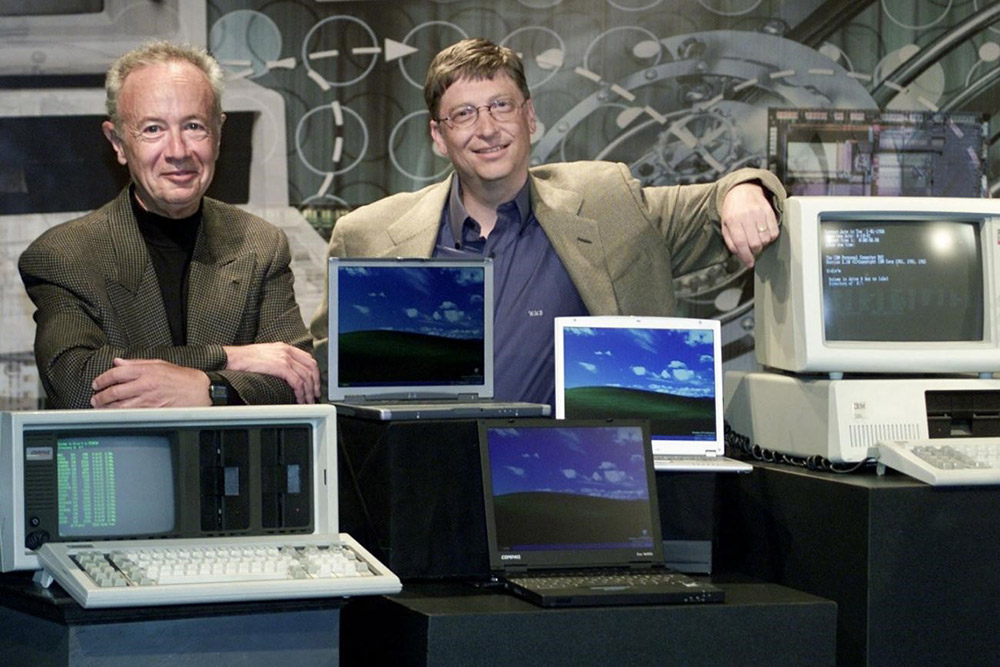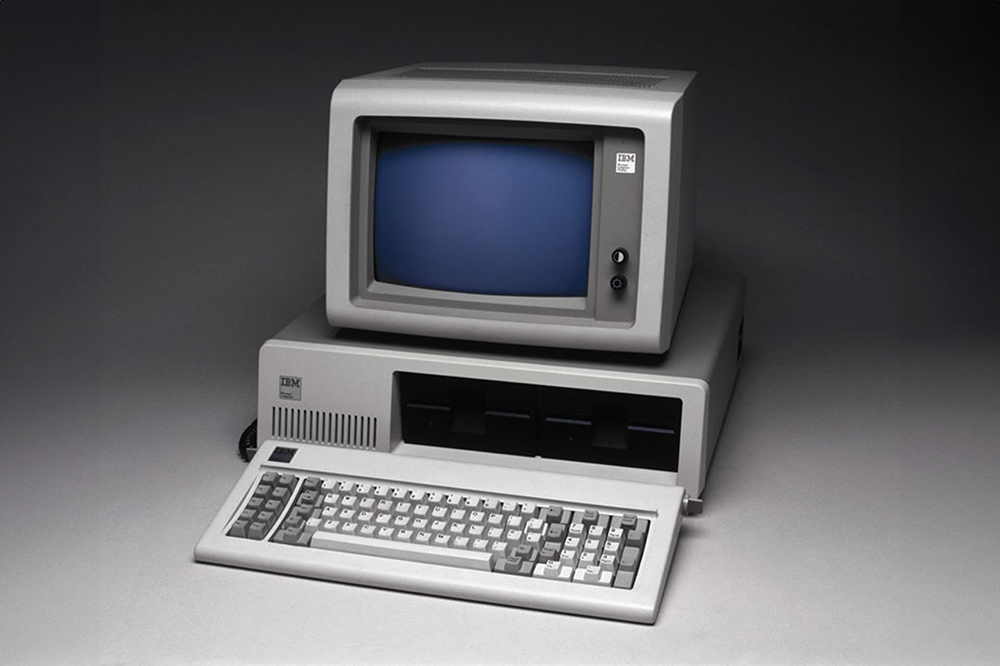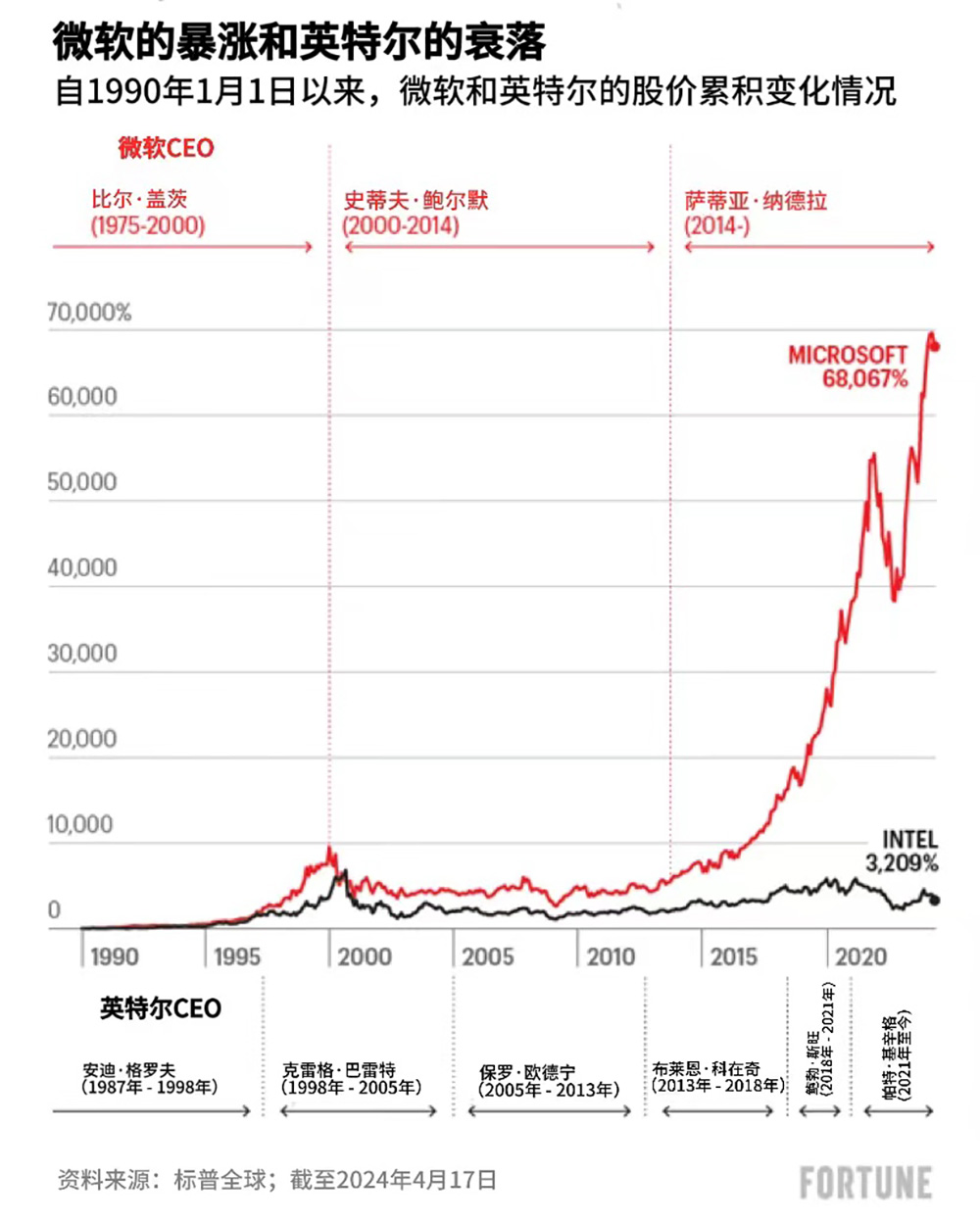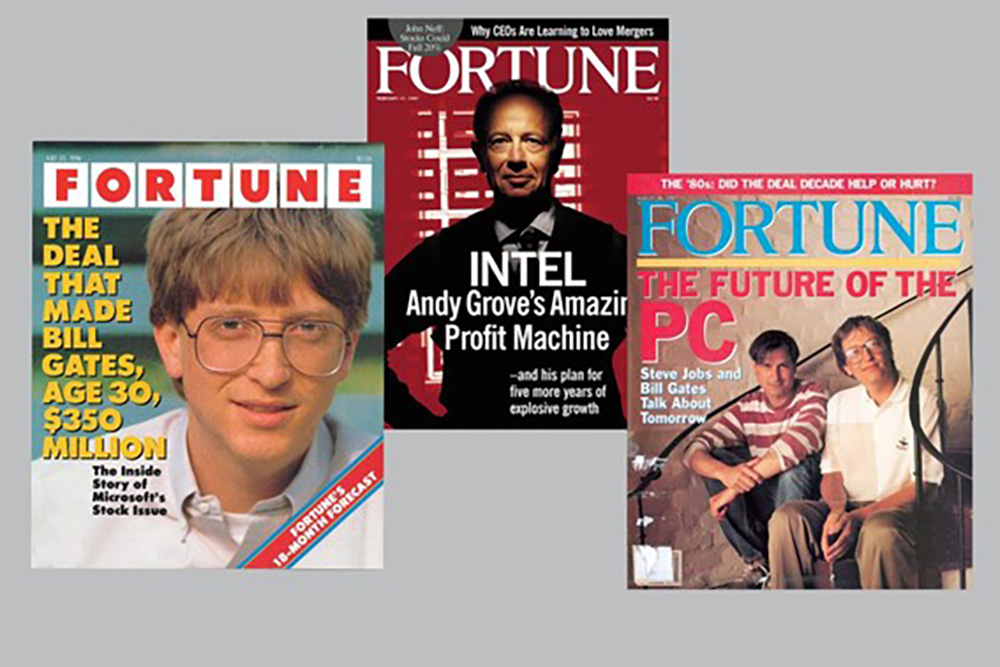
那是在2006年,,作為全球計算機芯片領(lǐng)域的領(lǐng)導(dǎo)者,英特爾憑借在需求最高的個人電腦芯片和數(shù)據(jù)中心芯片領(lǐng)域的主導(dǎo)地位,,營收和利潤雙雙創(chuàng)下歷史紀(jì)錄,。喬布斯希望英特爾為當(dāng)時還沒有問世的一款產(chǎn)品,也就是后來的iPhone手機,生產(chǎn)一種不同類型的芯片,。
歐德寧知道,,手機和平板設(shè)備的芯片將成為下一個熱門領(lǐng)域,但英特爾必須把大量資本和最優(yōu)秀的人才,,投入到公司現(xiàn)有的利潤豐厚的業(yè)務(wù),。此外,他在七年后對《大西洋》表示:“沒有人知道iPhone會有什么影響,。他們對一款芯片感興趣,,希望為它支付特定的價格,但不愿意多支付一美元,。這個價格低于我們的預(yù)期成本,。我無法接受?!彼诓痪弥笮度蜟EO,。
歐德寧在2017年去世。從許多方面來看,,他都是一位非常成功的CEO,。但如果英特爾做了相反的決定,它可能已經(jīng)成為后PC世代的芯片業(yè)巨頭,。它曾嘗試成為一個重要的市場參與者,,但卻虧損了數(shù)十億美元,于是2016年,,英特爾放棄了手機芯片業(yè)務(wù),。歐德寧在離開公司時,似乎意識到他的決定的重要影響:“如果我們接受了蘋果的要求,,世界將會變得截然不同?!?/p>

與此同時,,在英特爾以北約800英里的西雅圖,微軟在互聯(lián)網(wǎng),、移動設(shè)備,、社交媒體和搜索主導(dǎo)的科技領(lǐng)域,正在努力尋找自己的定位,。它的努力并沒有打動投資者,。沒有人能夠預(yù)見,幾年后,微軟做出的幾個關(guān)鍵決策,,讓公司變成了人工智能領(lǐng)域的巨頭,,并使股價暴漲。
不久之前,,微軟和英特爾曾經(jīng)雄霸科技界,。它們彼此既不是競爭對手,也不是重要客戶,,但紐約大學(xué)(New York University)的亞當(dāng)·布蘭登伯格和耶魯大學(xué)(Yale)的巴里·納萊巴夫認(rèn)為兩家公司是“互補的”,。多年來,微軟憑借在使用英特爾芯片的電腦上運行的Windows操作系統(tǒng)賺得盆滿缽滿,,而英特爾則設(shè)計運行Windows系統(tǒng)的新芯片(因此,,它們組成了所謂的“Wintel”)。兩家公司的聯(lián)盟,,促進了20世紀(jì)90年代領(lǐng)先的科技產(chǎn)品個人電腦的蓬勃發(fā)展,。微軟的比爾·蓋茨成為一名著名的書呆子億萬富翁,而英特爾CEO安迪·格羅夫被《時代》雜志評為1997年年度人物,。
但后來兩家公司的發(fā)展方向卻大相徑庭,。2000年,微軟是全世界最有價值的公司,,而且在失去這個稱號多年之后,,微軟現(xiàn)在已重回巔峰。2000年,,英特爾的市值排在全球第6位,,而且是全球最大的半導(dǎo)體廠商;現(xiàn)在其市值排在第69位,,在半導(dǎo)體行業(yè)營收排在第2位,,遠(yuǎn)遠(yuǎn)落后于排在首位的臺積電(TSMC)(在某些年份還落后于三星(Samsung))。

一位《財富》500強公司的CEO,在職業(yè)生涯中要做出數(shù)千個決策,,其中有些決策會產(chǎn)生重大影響,。有些事情在事后很容易解釋,比如微軟成為人工智能領(lǐng)域的先驅(qū),,谷歌(Google)變成龐然大物,,影碟租賃公司Blockbuster銷聲匿跡,但這些事情并非上天的安排,。決定命運的決策往往在事后才會被確定,。微軟和英特爾的故事就是最好的佐證。這兩家巨頭公司成功和失敗的研究案例,不僅為谷歌,、OpenAI,、亞馬遜(Amazon)等目前領(lǐng)先的公司提供了商業(yè)戰(zhàn)略的典范,也為希望在未來十年生存并繁榮發(fā)展的《財富》500強公司領(lǐng)導(dǎo)者提供了一堂商業(yè)戰(zhàn)略大師課,。
Wintel的起源
這兩家公司的創(chuàng)辦時間僅相隔了七年,。英特爾創(chuàng)建于1968年,創(chuàng)始人包括計算機芯片的共同發(fā)明者羅伯特·諾伊斯和戈登·摩爾,。摩爾在一篇開創(chuàng)性的文章中預(yù)言,,芯片上的晶體管數(shù)量每年會翻一番,后來修正為每兩年翻一番,,這就是后人所說的“摩爾定律”,。安迪·格羅夫是英特爾的三號員工。這三人至今仍被視為行業(yè)巨頭,。
眾所周知,,比爾·蓋茨從哈佛大學(xué)(Harvard)肄業(yè)后,與童年好友保羅·艾倫共同創(chuàng)立了微軟,。他們對為個人計算機(也被稱為微型計算機)這個新概念開發(fā)軟件的前景感到興奮,。他們在1975年創(chuàng)建了微軟。

1980年,IBM決定生產(chǎn)一款PC,,為了迅速推進,,決定使用其他公司開發(fā)的現(xiàn)有芯片和現(xiàn)有操作系統(tǒng),于是這兩家公司的發(fā)展道路交織在一起,。IBM選擇了英特爾的芯片和微軟的操作系統(tǒng),,這深刻改變了這兩家公司和公司的經(jīng)營者。IBM的規(guī)模和聲譽使其設(shè)計成為行業(yè)標(biāo)準(zhǔn),,因此后來幾十年,,無論哪家廠商的PC,全部都使用了英特爾的芯片和微軟的操作系統(tǒng),。隨著PC席卷美國和全球,英特爾和微軟成了科技勝利,、魅力,、成功和1982年至2000年歷史性牛市的象征。
后來,,一切都發(fā)生了改變,。
蓋茨和格羅夫的“統(tǒng)治”結(jié)束
2000年10月,《財富》雜志發(fā)表了一篇文章,文章的插圖將蓋茨和格羅夫描繪成埃及不朽的獅身人面像,。文章標(biāo)題是《他們的統(tǒng)治結(jié)束了》,。
文章解釋道:“蓋茨和格羅夫抓住了計算機架構(gòu)中的兩個關(guān)鍵節(jié)點——操作系統(tǒng)和PC微處理器,從而獲得了霸權(quán)地位,。但在由通用互聯(lián)網(wǎng)協(xié)議連接起來的更多樣化的新IT世界,,沒有這種明顯的關(guān)鍵節(jié)點可以搶占?!?/p>
因此,,這兩家公司開始了長達(dá)數(shù)年的身份危機。英特爾的PC芯片和微軟的PC操作系統(tǒng)和應(yīng)用程序仍然是利潤豐厚的業(yè)務(wù),,但這兩家公司及其投資者都知道這并非未來之路,。未來到底是什么?誰將引領(lǐng)新時代,?
2000年1月,,蓋茨在擔(dān)任CEO 25年后卸任,由微軟總裁,、蓋茨的大學(xué)好友史蒂夫·鮑爾默接任,;蓋茨仍任董事長。兩天后,,微軟股價暴跌,。當(dāng)天,微軟的市值為6,190億美元,,在之后的近18年它都沒有再達(dá)到這個水平,。
2000年時,格羅夫已不再擔(dān)任英特爾CEO,,該職位在1998年就已經(jīng)由長期擔(dān)任公司高管的克雷格·巴雷特接任,。但作為英特爾富有遠(yuǎn)見卓識和最成功的CEO,格羅夫仍擔(dān)任董事會主席,,發(fā)揮著重要作用,。他的健康狀況成了問題;1995年,,他被診斷出患有前列腺癌,,2000年又被診斷出患有帕金森氏病,。英特爾的股價一路飆升,,直到8月,公司市值達(dá)到5,000億美元的最高峰,。從那以后,,公司股價再也沒能重回巔峰,。
最重要的是,,2000年的互聯(lián)網(wǎng)似乎開始讓W(xué)intel變得無關(guān)緊要。
在英特爾,,巴雷特進行了一系列收購,,其中許多收購對象來自電信和無線技術(shù)領(lǐng)域。在概念上,,這是明智之舉,。手機正在走向主流,需要新型芯片,。哈佛商學(xué)院(Harvard Business School)教授,、時任英特爾董事會成員的大衛(wèi)·約菲表示:“克雷格試圖通過收購新業(yè)務(wù),大力推動英特爾業(yè)務(wù)多元化,。但我想說那并不是他的專長,,這些收購都以失敗告終。我們花費了120億美元,,結(jié)果回報為零或負(fù)數(shù),。”
在互聯(lián)網(wǎng)泡沫破滅后的蕭條時期,,巴雷特繼續(xù)投入數(shù)十億美元新建芯片工廠(即晶圓廠)和開發(fā)新生產(chǎn)技術(shù),,以便在需求反彈時英特爾能夠占據(jù)有利地位。這就引出了在Wintel的傳奇歷程背后最重要的經(jīng)驗教訓(xùn)之一:即使在轉(zhuǎn)型時期,,公司幾乎也會不由自主地保護現(xiàn)有業(yè)務(wù),。這樣做通常聽起來很合理,但卻存在讓公司未來陷入困境的危險,。正如偉大的管理作家彼得·德魯克所說:“如果領(lǐng)導(dǎo)者無法擺脫昨天,,放棄昨天,他們就無法創(chuàng)造明天,?!?/p>
“我們搞砸了”
2005年至2010年擔(dān)任微軟高管的雷·奧茲表示,在2000年代的微軟,,“關(guān)于PC的形狀和體積,、操作系統(tǒng)的利潤率,以及Word或Excel等應(yīng)用程序未來會發(fā)生哪些變化,,情況并不明朗,。未來PC將會消亡,還是會繼續(xù)增長和蓬勃發(fā)展,,微軟內(nèi)部以及整個行業(yè)都就此展開了激烈討論,。”也許Word,、Excel和那些安裝在硬盤上的其他應(yīng)用程序,,會遷移到互聯(lián)網(wǎng)上,類似于2006年初推出的Google Docs,。在這種情況下,,微軟需要一種新的商業(yè)模式。微軟應(yīng)該開發(fā)一個新商業(yè)模式嗎,?一些高管這樣認(rèn)為,。但沒有人知道確切答案。
在這段時期,,微軟不再是企業(yè)創(chuàng)新的典范,,而是陷入了成功的公司被顛覆時經(jīng)常會發(fā)生的狀況。奧茲解釋道:“當(dāng)你擁有豐富的資源且面臨多個生存威脅時,,保護公司最自然的做法就是采取并行發(fā)展策略,。更加困難的是堅持己見做出選擇,并全力以赴,。不幸的是,,采取并行發(fā)展策略會在各個部門之間造成隔閡和內(nèi)部沖突,這會導(dǎo)致公司經(jīng)營失靈,?!?/p>
隨著團隊之間相互爭搶主導(dǎo)地位,微軟錯過了自PC時代以來最賺錢的兩個業(yè)務(wù):搜索和手機,。這些失誤并不致命,,因為微軟仍然擁有兩個可靠且高利潤的業(yè)務(wù):Windows操作系統(tǒng)和Office系列應(yīng)用程序。但用德魯克的話來說,,這些都是過時的業(yè)務(wù)。投資者沒有看到實質(zhì)性的未來業(yè)務(wù),,這就是為什么多年來微軟的股價持續(xù)低迷,。錯失搜索和手機業(yè)務(wù)并未威脅到微軟的生存,卻影響到微軟在日新月異的新時代的相關(guān)性和重要性,,這最終可能損害公司在投資者和全球最優(yōu)秀員工中的吸引力,。這些關(guān)鍵失誤背后的原因很有教育意義。
2000年,,谷歌還是一家名不見經(jīng)傳的互聯(lián)網(wǎng)搜索初創(chuàng)公司,,沒有明確的商業(yè)模式,但它有一種大致的理念,,認(rèn)為賣廣告有利可圖,。最后的結(jié)果人盡皆知:谷歌在2023年的廣告收入高達(dá)2,380億美元。這對于微軟而言是一種完全陌生的模式,微軟的收入依賴的是開發(fā)和高價出售軟件,。向用戶免費,?賣廣告?微軟從來沒有經(jīng)營過與谷歌類似的業(yè)務(wù)。當(dāng)谷歌的模式得到驗證時,,微軟已經(jīng)遠(yuǎn)遠(yuǎn)落后。據(jù)網(wǎng)絡(luò)流量分析公司StatCounter稱,,如今微軟的必應(yīng)(Bing)搜索引擎在全球各平臺上的市場份額僅為3%,。而谷歌的市場份額為92%。

微軟在手機領(lǐng)域也遭遇了基本類似的失敗,,等到微軟完全理解了手機業(yè)務(wù)的結(jié)構(gòu)已經(jīng)為時已晚。微軟以為手機行業(yè)的發(fā)展會與PC行業(yè)類似,,就像戴爾(Dell)等PC銷售商用英特爾的芯片和微軟的軟件組合成最終產(chǎn)品一樣,。但是蘋果與眾不同的iPhone商業(yè)模式大獲成功,蘋果自己設(shè)計芯片并編寫軟件,。手機行業(yè)的另一大贏家是谷歌的安卓智能手機操作系統(tǒng),,它同樣無視了PC模式。谷歌并不出售操作系統(tǒng),而是將其免費提供給三星,、摩托羅拉(Motorola)等手機制造商,。谷歌的收入來自在每部手機上安裝其搜索引擎,并在用戶購買應(yīng)用時,,向應(yīng)用開發(fā)者收取一筆費用,。
比爾·蓋茨承認(rèn),微軟在手機領(lǐng)域的失誤改變了公司的命運,。他在2020年回顧自己的職業(yè)生涯時表示:“這是我在明顯在我們技能范圍以內(nèi)的事情上犯下的最大錯誤,。”
英特爾同樣以類似的方式,,錯失了手機行業(yè)的巨大商機,。它無法適應(yīng)變化。英特爾意識到手機行業(yè)的機會,,早在2000年代初,就為備受歡迎的黑莓(BlackBerry)手機供應(yīng)芯片,。問題是,,這些芯片的設(shè)計者并非英特爾,而是英國公司Arm,。Arm設(shè)計芯片,,但并不生產(chǎn)芯片。Arm設(shè)計的一種芯片架構(gòu),,功耗低于其他芯片,,這對于手機至關(guān)重要。英特爾負(fù)責(zé)生產(chǎn)芯片,,并向Arm支付專利費,。

英特爾更愿意使用自己的x86架構(gòu)生產(chǎn)手機芯片,,這可以理解,。保羅·歐德寧決定停止生產(chǎn)Arm芯片,并為手機開發(fā)一款x86芯片——約菲認(rèn)為,,事后來看,,“這是一個重大戰(zhàn)略錯誤”。他回憶道:“當(dāng)時的計劃是,,我們將在一年內(nèi)開發(fā)出一款競爭產(chǎn)品,,結(jié)果十年過去了也沒有實現(xiàn)這個計劃。并不是我們錯過了手機帶來的機遇,而是我們搞砸了,?!?
探索巨大潮流
2000年是英特爾和微軟的轉(zhuǎn)折點,2013年也是如此,。廣義上說,,它們陷入了同樣的困境:曾令它們偉大的業(yè)務(wù)仍在給公司創(chuàng)造收入;它們想要參與下一個大機遇卻為時已晚或不成功,;它們都在努力尋找下一個可以主導(dǎo)的巨大潮流,。它們的股價在至少十年內(nèi)或多或少陷入低迷。2013年5月,,保羅·歐德寧不再擔(dān)任英特爾CEO,。8月,史蒂夫·鮑爾默宣布將辭去微軟CEO的職務(wù),。
接班計劃是董事會的頭等大事,,這比起董事會的其他所有任務(wù)加起來都更為重要。這其中總是會存在較高的風(fēng)險,。英特爾和微軟董事會相隔9個月處理公司接班人問題的方式,,在很大程度上可以解釋為什么兩家公司會戲劇性地走上不同發(fā)展道路。
在歐德寧的接班人布賴恩·科在奇的領(lǐng)導(dǎo)下,,英特爾始終無法按時交付新芯片——諷刺的是,,英特爾甚至無法像競爭對手一樣,跟上摩爾定律,,而且公司的市場份額萎縮,。該公司放棄了智能手機芯片。一項調(diào)查發(fā)現(xiàn)科在奇與一名員工有過兩廂情愿的親密關(guān)系,,于是擔(dān)任了五年CEO的科在奇突然辭職,。首席財務(wù)官鮑勃·斯旺接任CEO,,而生產(chǎn)問題持續(xù)到2021年,,英特爾在其歷史上首次面臨其芯片比競爭對手落后兩代的窘境。這些競爭對手是中國臺灣的臺積電(TSMC)和韓國的三星,。
在危機中,,英特爾董事會召回了從公司離職11年的工程師帕特·基辛格?;粮裨诠竟ぷ髁?0年,,辭職后曾擔(dān)任EMC的高管,后來成為VMware首席執(zhí)行官,。作為英特爾的CEO,,基辛格宣布了一個雄心勃勃且成本高昂的計劃,,旨在奪回公司在芯片技術(shù)領(lǐng)域的世界領(lǐng)導(dǎo)地位。
微軟董事會花了近六個月時間,,在全球范圍內(nèi)尋找鮑爾默的繼任者,。外界公開討論的候選人至少有17人。英國和拉斯維加斯的博彩商對最終的勝出者開出了賠率,;最近擔(dān)任CEO滿十年的薩提亞·納德拉,,當(dāng)時的賠率是14賠1,并不被看好,。
納德拉可以說是多年來乃至數(shù)十年來,,各行各業(yè)最好的公司接班人選擇。在他的領(lǐng)導(dǎo)下,,微軟股價最終突破了14年的交易區(qū)間并大幅上漲,,漲幅超過1,000%。微軟再次成為全球市值最高的公司,,最近的市值高達(dá)3.1萬億美元,。基辛格擔(dān)任英特爾CEO剛滿三年,,因此還無法全面評價,;業(yè)內(nèi)專家們都在猜測他是否能成為英特爾的納德拉。但這兩位CEO都為公司如何走出過去,、邁向未來,提供了有用范例,。
納德拉以外來者的視角審視公司,,推動公司轉(zhuǎn)型,在沒有引起太大轟動的情況下進行大刀闊斧的改革,。他首先讓Office應(yīng)用程序(Word,,Excel)與蘋果的iPhone和iPad兼容——這在微軟看來是異端邪說,因為微軟把蘋果視為主要敵人,。但納德拉意識到,,這兩家公司之間沒有太多競爭,為什么不讓更多人依賴Office應(yīng)用程序呢,?這一舉措向公司和全世界傳遞了一個信息:微軟文化中根深蒂固的傲慢將大為減少?,F(xiàn)在微軟可以接受與其他公司實現(xiàn)互操作。
這對微軟而言是一種全新的商業(yè)模式,,未來還會有更多新的模式出現(xiàn),。例如,納德拉收購了LinkedIn,,LinkedIn在微軟已經(jīng)徹底錯過的社交媒體領(lǐng)域占有一席之地,。然后,微軟又收購了曾不屑一顧的開源代碼庫GitHub。這兩筆交易以及其他幾筆交易都大獲成功,。
總的來說,,納德拉為新環(huán)境帶來了一種全新的領(lǐng)導(dǎo)風(fēng)格。在一家以惡意內(nèi)斗而著稱的公司,,可能因為內(nèi)訌讓行動陷入癱瘓,,但他卻解決了長期以來圍繞重大項目的辯論。例如,,2016年,,他出售了微軟在他成為CEO前一年收購的諾基亞(Nokia)手機業(yè)務(wù),承認(rèn)公司已經(jīng)輸?shù)袅耸謾C戰(zhàn),。一位前高管表示:“人們不太理解為什么微軟在薩蒂亞的領(lǐng)導(dǎo)下能夠一片欣欣向榮,。他的超能力在于做出選擇,消除沖突,,讓業(yè)務(wù)蓬勃發(fā)展,。”
在英特爾,,基辛格也掀起了挑戰(zhàn)公司文化的改革,。該公司憑借設(shè)計尖端芯片和具備行業(yè)領(lǐng)先的制造技術(shù)而樹立了行業(yè)主導(dǎo)地位。帶著這種強烈的自豪感,,單獨創(chuàng)建一家代工廠,,生產(chǎn)他人設(shè)計的芯片,被視為大逆不道,。然而,,在基辛格的領(lǐng)導(dǎo)下,英特爾創(chuàng)立了新代工業(yè)務(wù),,同時更多地依賴其他代工廠生產(chǎn)自己的芯片,,包括全球最大的芯片制造商臺積電——這對公司文化來說是雙重沖擊。
讓一家有悠久文化傳統(tǒng)的老牌公司,,像納德拉和基辛格一樣接受貌似很陌生的商業(yè)模式,,可能是一個痛苦的艱難過程。通常只有新CEO才能帶來開放的心態(tài),,實現(xiàn)這種轉(zhuǎn)變,。當(dāng)一家公司需要更新其企業(yè)戰(zhàn)略時,也會出現(xiàn)同樣的問題,。微軟多年來一直在尋找和討論下一個熱門領(lǐng)域,,但納德拉認(rèn)為公司沒有必要去尋找一個可能潛力巨大的、面向未來的新業(yè)務(wù),。它已經(jīng)有了一個這樣的業(yè)務(wù):云計算服務(wù)Azure,。Amazon Web Services無論過去還是現(xiàn)在都業(yè)內(nèi)領(lǐng)先,,但Azure已經(jīng)成為勢頭強勁的第二名,因為納德拉為該業(yè)務(wù)投入了充足的資本和一些公司最聰明的員工,。他還在ChatGPT的開發(fā)者OpenAI進行了一筆非同尋常的投資,,早在該公司名聲大噪之前就承諾向其投資130億美元。現(xiàn)在Azure向其客戶提供OpenAI的技術(shù),。按照德魯克的說法,,這就是一項蓬勃發(fā)展的未來業(yè)務(wù)。
基辛格對英特爾戰(zhàn)略的改革更加激進,。他大膽利用美國政府的數(shù)十億美元,,并大獲成功。通過《芯片與科學(xué)法案》(CHIPS and Science Act),,英特爾可以獲得多達(dá)440億美元的援助,,用于未來幾年在美國新建芯片工廠。他對《財富》雜志表示:“我喜歡開玩笑地說,,為了推動《芯片法案》,,沒有人比我投入的精力更多。我見過大量參議員,、眾議員和各州的政治團體,。我為了它付出了很多努力?!?/p>
一個關(guān)鍵的觀點是,,對于微軟和英特爾這種有過成功經(jīng)歷的大公司,要擺脫過時的戰(zhàn)略并全面擁抱新戰(zhàn)略難度巨大,,有時候甚至是不可能的,。多年來,這兩家公司一直在嘗試卻未能成功,。還有一個相關(guān)的觀點是:對于納德拉和基辛格來說,這樣做更容易,,因為他們具有“內(nèi)部外來”領(lǐng)導(dǎo)者的優(yōu)勢,,對公司有深刻了解,但沒有深度參與公司的戰(zhàn)略,。納德拉在成為CEO之前長期從事Azure工作,,而不是Windows操作系統(tǒng)或Office應(yīng)用程序,而基辛格曾離開英特爾11年,,這讓他有機會重新思考一切,。
一個更重要的教訓(xùn)是,在這兩家偉大公司的發(fā)展歷程中,,接班計劃是最重要的因素,。過去24年,,微軟的整體表現(xiàn)優(yōu)于英特爾,在此期間,,微軟只有兩位CEO,,而英特爾卻經(jīng)歷了多達(dá)5位CEO。大多數(shù)人在解釋一家公司的業(yè)績時會研究CEO,,但他們首先應(yīng)該研究的是選擇CEO的人,,也就是公司的董事會。
回顧這些故事,,我們禁不住會問“如果……會怎么樣”這樣的問題,。如果保羅·歐德寧同意了史蒂夫·喬布斯的要求會怎么樣?如果英特爾或微軟的任何一位CEO另有其人會怎么樣,?如果在另一位CEO的領(lǐng)導(dǎo)下,,英特爾開發(fā)出一款成功的GPU,也就是如今驅(qū)動人工智能引擎的芯片(它曾進行過嘗試)——你還會聽說過英偉達(dá)(Nvidia)嗎,?比爾·蓋茨在2019年表示:“我們差一點點就成為主流手機操作系統(tǒng),。”如果這一點點稍微發(fā)生了偏移會怎么樣,?你今天會用哪個品牌的手機,?
這些問題會令人陶醉其中無法自拔,當(dāng)然不會有任何答案,?;仡櫄v史和思考這些假設(shè)問題的價值在于,提醒我們領(lǐng)導(dǎo)者每天都在創(chuàng)造未來,,如果他們不能從歷史中總結(jié)經(jīng)驗教訓(xùn),,那就是失職。
Wintel研究案例的五個啟示
1. 成功可能是一家公司最大的敵人,。偉大的管理作家彼得·德魯克曾說過,,每家公司必須“拋棄昨天”,才能“創(chuàng)造明天”,。但在一家成功的公司中,,領(lǐng)導(dǎo)者會不由自主地保護“昨天”。英特爾和微軟為創(chuàng)造明天努力了多年,。
2. 領(lǐng)導(dǎo)者必須愿意接受貌似奇怪的商業(yè)模式,。無論是免費提供軟件還是將生產(chǎn)他人設(shè)計的芯片作為一項獨立業(yè)務(wù),微軟和英特爾都在改變經(jīng)營策略,,應(yīng)對競爭對手,。
3. 統(tǒng)一思想。辯論在一定程度上是健康的,,但在微軟,,辯論持續(xù)了太長時間,,直到納德拉成為CEO并明確了優(yōu)先事項才結(jié)束。在英特爾,,接連更換的CEO們支持不同解決方案來應(yīng)對其業(yè)務(wù)下滑的問題,,這導(dǎo)致公司長期處于戰(zhàn)略混亂的狀態(tài)。
4. 接班計劃是董事會的頭等大事,,這比起董事會的其他所有任務(wù)加起來都更為重要,。每個人都知道這一點,但一些董事會依舊沒有做好這項工作,。如果他們犯了錯,,其他所有教訓(xùn)都無關(guān)緊要。過去24年,,微軟的整體表現(xiàn)優(yōu)于英特爾,,在此期間,微軟只有兩位CEO,,而英特爾卻經(jīng)歷了多達(dá)5位CEO,。
5. 失敗不會致命。Wintel的故事提醒我們,,所有公司,,包括最優(yōu)秀的公司,都會遭遇失敗并陷入危機,。沒有公司能夠幸免,。任何公司的領(lǐng)導(dǎo)者,甚至是最杰出的公司,,都必須時刻準(zhǔn)備運用組織救援技能,,并且知道這也是一家偉大公司的一部分。(財富中文網(wǎng))
譯者:劉進龍
審校:汪皓
史蒂夫·喬布斯不喜歡聽到別人說“不”,。但英特爾(Intel)CEO保羅·歐德寧就曾這樣回復(fù)喬布斯,。
那是在2006年,作為全球計算機芯片領(lǐng)域的領(lǐng)導(dǎo)者,,英特爾憑借在需求最高的個人電腦芯片和數(shù)據(jù)中心芯片領(lǐng)域的主導(dǎo)地位,,營收和利潤雙雙創(chuàng)下歷史紀(jì)錄。喬布斯希望英特爾為當(dāng)時還沒有問世的一款產(chǎn)品,,也就是后來的iPhone手機,生產(chǎn)一種不同類型的芯片,。
歐德寧知道,,手機和平板設(shè)備的芯片將成為下一個熱門領(lǐng)域,但英特爾必須把大量資本和最優(yōu)秀的人才,,投入到公司現(xiàn)有的利潤豐厚的業(yè)務(wù),。此外,,他在七年后對《大西洋》表示:“沒有人知道iPhone會有什么影響。他們對一款芯片感興趣,,希望為它支付特定的價格,,但不愿意多支付一美元。這個價格低于我們的預(yù)期成本,。我無法接受,。”他在不久之后卸任CEO。
歐德寧在2017年去世,。從許多方面來看,他都是一位非常成功的CEO,。但如果英特爾做了相反的決定,,它可能已經(jīng)成為后PC世代的芯片業(yè)巨頭,。它曾嘗試成為一個重要的市場參與者,但卻虧損了數(shù)十億美元,,于是2016年,,英特爾放棄了手機芯片業(yè)務(wù),。歐德寧在離開公司時,,似乎意識到他的決定的重要影響:“如果我們接受了蘋果的要求,,世界將會變得截然不同,?!?/p>
1981年推出的IBM電腦,,讓英特爾的芯片和微軟(Microsoft)的軟件,,走進了全世界的家庭和企業(yè)。
與此同時,,在英特爾以北約800英里的西雅圖,,微軟在互聯(lián)網(wǎng),、移動設(shè)備、社交媒體和搜索主導(dǎo)的科技領(lǐng)域,,正在努力尋找自己的定位,。它的努力并沒有打動投資者。沒有人能夠預(yù)見,,幾年后,,微軟做出的幾個關(guān)鍵決策,,讓公司變成了人工智能領(lǐng)域的巨頭,,并使股價暴漲。
不久之前,微軟和英特爾曾經(jīng)雄霸科技界,。它們彼此既不是競爭對手,,也不是重要客戶,,但紐約大學(xué)(New York University)的亞當(dāng)·布蘭登伯格和耶魯大學(xué)(Yale)的巴里·納萊巴夫認(rèn)為兩家公司是“互補的”,。多年來,微軟憑借在使用英特爾芯片的電腦上運行的Windows操作系統(tǒng)賺得盆滿缽滿,,而英特爾則設(shè)計運行Windows系統(tǒng)的新芯片(因此,它們組成了所謂的“Wintel”)。兩家公司的聯(lián)盟,,促進了20世紀(jì)90年代領(lǐng)先的科技產(chǎn)品個人電腦的蓬勃發(fā)展。微軟的比爾·蓋茨成為一名著名的書呆子億萬富翁,而英特爾CEO安迪·格羅夫被《時代》雜志評為1997年年度人物,。
但后來兩家公司的發(fā)展方向卻大相徑庭,。2000年,微軟是全世界最有價值的公司,,而且在失去這個稱號多年之后,,微軟現(xiàn)在已重回巔峰。2000年,,英特爾的市值排在全球第6位,,而且是全球最大的半導(dǎo)體廠商;現(xiàn)在其市值排在第69位,,在半導(dǎo)體行業(yè)營收排在第2位,,遠(yuǎn)遠(yuǎn)落后于排在首位的臺積電(TSMC)(在某些年份還落后于三星(Samsung))。
這兩家科技巨頭的股票曾一度有類似的走勢,,直到微軟開始進行大膽的嘗試,。
一位《財富》500強公司的CEO,在職業(yè)生涯中要做出數(shù)千個決策,,其中有些決策會產(chǎn)生重大影響,。有些事情在事后很容易解釋,比如微軟成為人工智能領(lǐng)域的先驅(qū),,谷歌(Google)變成龐然大物,,影碟租賃公司Blockbuster銷聲匿跡,但這些事情并非上天的安排,。決定命運的決策往往在事后才會被確定,。微軟和英特爾的故事就是最好的佐證。這兩家巨頭公司成功和失敗的研究案例,,不僅為谷歌,、OpenAI,、亞馬遜(Amazon)等目前領(lǐng)先的公司提供了商業(yè)戰(zhàn)略的典范,也為希望在未來十年生存并繁榮發(fā)展的《財富》500強公司領(lǐng)導(dǎo)者提供了一堂商業(yè)戰(zhàn)略大師課,。
Wintel的起源
這兩家公司的創(chuàng)辦時間僅相隔了七年,。英特爾創(chuàng)建于1968年,創(chuàng)始人包括計算機芯片的共同發(fā)明者羅伯特·諾伊斯和戈登·摩爾,。摩爾在一篇開創(chuàng)性的文章中預(yù)言,,芯片上的晶體管數(shù)量每年會翻一番,后來修正為每兩年翻一番,,這就是后人所說的“摩爾定律”,。安迪·格羅夫是英特爾的三號員工。這三人至今仍被視為行業(yè)巨頭,。
眾所周知,,比爾·蓋茨從哈佛大學(xué)(Harvard)肄業(yè)后,與童年好友保羅·艾倫共同創(chuàng)立了微軟,。他們對為個人計算機(也被稱為微型計算機)這個新概念開發(fā)軟件的前景感到興奮,。他們在1975年創(chuàng)建了微軟。
過去數(shù)十年,,《財富》雜志封面上的蓋茨和格羅夫,。
1980年,IBM決定生產(chǎn)一款PC,,為了迅速推進,,決定使用其他公司開發(fā)的現(xiàn)有芯片和現(xiàn)有操作系統(tǒng),于是這兩家公司的發(fā)展道路交織在一起,。IBM選擇了英特爾的芯片和微軟的操作系統(tǒng),,這深刻改變了這兩家公司和公司的經(jīng)營者。IBM的規(guī)模和聲譽使其設(shè)計成為行業(yè)標(biāo)準(zhǔn),,因此后來幾十年,,無論哪家廠商的PC,全部都使用了英特爾的芯片和微軟的操作系統(tǒng),。隨著PC席卷美國和全球,,英特爾和微軟成了科技勝利、魅力,、成功和1982年至2000年歷史性牛市的象征。
后來,,一切都發(fā)生了改變,。
蓋茨和格羅夫的“統(tǒng)治”結(jié)束
2000年10月,,《財富》雜志發(fā)表了一篇文章,文章的插圖將蓋茨和格羅夫描繪成埃及不朽的獅身人面像,。文章標(biāo)題是《他們的統(tǒng)治結(jié)束了》,。
文章解釋道:“蓋茨和格羅夫抓住了計算機架構(gòu)中的兩個關(guān)鍵節(jié)點——操作系統(tǒng)和PC微處理器,,從而獲得了霸權(quán)地位,。但在由通用互聯(lián)網(wǎng)協(xié)議連接起來的更多樣化的新IT世界,,沒有這種明顯的關(guān)鍵節(jié)點可以搶占,?!?/p>
因此,這兩家公司開始了長達(dá)數(shù)年的身份危機。英特爾的PC芯片和微軟的PC操作系統(tǒng)和應(yīng)用程序仍然是利潤豐厚的業(yè)務(wù),,但這兩家公司及其投資者都知道這并非未來之路,。未來到底是什么?誰將引領(lǐng)新時代,?
2000年1月,蓋茨在擔(dān)任CEO 25年后卸任,,由微軟總裁、蓋茨的大學(xué)好友史蒂夫·鮑爾默接任,;蓋茨仍任董事長。兩天后,,微軟股價暴跌,。當(dāng)天,,微軟的市值為6,190億美元,在之后的近18年它都沒有再達(dá)到這個水平,。
2000年時,,格羅夫已不再擔(dān)任英特爾CEO,,該職位在1998年就已經(jīng)由長期擔(dān)任公司高管的克雷格·巴雷特接任,。但作為英特爾富有遠(yuǎn)見卓識和最成功的CEO,,格羅夫仍擔(dān)任董事會主席,發(fā)揮著重要作用,。他的健康狀況成了問題,;1995年,他被診斷出患有前列腺癌,,2000年又被診斷出患有帕金森氏病,。英特爾的股價一路飆升,直到8月,,公司市值達(dá)到5,000億美元的最高峰。從那以后,,公司股價再也沒能重回巔峰,。
最重要的是,2000年的互聯(lián)網(wǎng)似乎開始讓W(xué)intel變得無關(guān)緊要,。
在英特爾,,巴雷特進行了一系列收購,,其中許多收購對象來自電信和無線技術(shù)領(lǐng)域。在概念上,,這是明智之舉,。手機正在走向主流,,需要新型芯片,。哈佛商學(xué)院(Harvard Business School)教授、時任英特爾董事會成員的大衛(wèi)·約菲表示:“克雷格試圖通過收購新業(yè)務(wù),,大力推動英特爾業(yè)務(wù)多元化,。但我想說那并不是他的專長,這些收購都以失敗告終,。我們花費了120億美元,,結(jié)果回報為零或負(fù)數(shù),。”
在互聯(lián)網(wǎng)泡沫破滅后的蕭條時期,,巴雷特繼續(xù)投入數(shù)十億美元新建芯片工廠(即晶圓廠)和開發(fā)新生產(chǎn)技術(shù),,以便在需求反彈時英特爾能夠占據(jù)有利地位。這就引出了在Wintel的傳奇歷程背后最重要的經(jīng)驗教訓(xùn)之一:即使在轉(zhuǎn)型時期,,公司幾乎也會不由自主地保護現(xiàn)有業(yè)務(wù)。這樣做通常聽起來很合理,,但卻存在讓公司未來陷入困境的危險。正如偉大的管理作家彼得·德魯克所說:“如果領(lǐng)導(dǎo)者無法擺脫昨天,,放棄昨天,他們就無法創(chuàng)造明天,?!?/p>
“我們搞砸了”
2005年至2010年擔(dān)任微軟高管的雷·奧茲表示,在2000年代的微軟,,“關(guān)于PC的形狀和體積,、操作系統(tǒng)的利潤率,以及Word或Excel等應(yīng)用程序未來會發(fā)生哪些變化,,情況并不明朗,。未來PC將會消亡,還是會繼續(xù)增長和蓬勃發(fā)展,,微軟內(nèi)部以及整個行業(yè)都就此展開了激烈討論,?!币苍SWord、Excel和那些安裝在硬盤上的其他應(yīng)用程序,,會遷移到互聯(lián)網(wǎng)上,類似于2006年初推出的Google Docs,。在這種情況下,,微軟需要一種新的商業(yè)模式。微軟應(yīng)該開發(fā)一個新商業(yè)模式嗎,?一些高管這樣認(rèn)為,。但沒有人知道確切答案。
在這段時期,,微軟不再是企業(yè)創(chuàng)新的典范,,而是陷入了成功的公司被顛覆時經(jīng)常會發(fā)生的狀況。奧茲解釋道:“當(dāng)你擁有豐富的資源且面臨多個生存威脅時,,保護公司最自然的做法就是采取并行發(fā)展策略,。更加困難的是堅持己見做出選擇,并全力以赴,。不幸的是,,采取并行發(fā)展策略會在各個部門之間造成隔閡和內(nèi)部沖突,這會導(dǎo)致公司經(jīng)營失靈,?!?/p>
隨著團隊之間相互爭搶主導(dǎo)地位,微軟錯過了自PC時代以來最賺錢的兩個業(yè)務(wù):搜索和手機,。這些失誤并不致命,,因為微軟仍然擁有兩個可靠且高利潤的業(yè)務(wù):Windows操作系統(tǒng)和Office系列應(yīng)用程序。但用德魯克的話來說,,這些都是過時的業(yè)務(wù),。投資者沒有看到實質(zhì)性的未來業(yè)務(wù),這就是為什么多年來微軟的股價持續(xù)低迷,。錯失搜索和手機業(yè)務(wù)并未威脅到微軟的生存,,卻影響到微軟在日新月異的新時代的相關(guān)性和重要性,這最終可能損害公司在投資者和全球最優(yōu)秀員工中的吸引力,。這些關(guān)鍵失誤背后的原因很有教育意義,。
2000年,谷歌還是一家名不見經(jīng)傳的互聯(lián)網(wǎng)搜索初創(chuàng)公司,,沒有明確的商業(yè)模式,,但它有一種大致的理念,認(rèn)為賣廣告有利可圖,。最后的結(jié)果人盡皆知:谷歌在2023年的廣告收入高達(dá)2,380億美元,。這對于微軟而言是一種完全陌生的模式,,微軟的收入依賴的是開發(fā)和高價出售軟件。向用戶免費,?賣廣告,?微軟從來沒有經(jīng)營過與谷歌類似的業(yè)務(wù)。當(dāng)谷歌的模式得到驗證時,,微軟已經(jīng)遠(yuǎn)遠(yuǎn)落后,。據(jù)網(wǎng)絡(luò)流量分析公司StatCounter稱,如今微軟的必應(yīng)(Bing)搜索引擎在全球各平臺上的市場份額僅為3%,。而谷歌的市場份額為92%,。
谷歌創(chuàng)始人謝爾蓋·布林(左)和拉里·佩奇讓微軟陷入了身份危機。
微軟在手機領(lǐng)域也遭遇了基本類似的失敗,,等到微軟完全理解了手機業(yè)務(wù)的結(jié)構(gòu)已經(jīng)為時已晚,。微軟以為手機行業(yè)的發(fā)展會與PC行業(yè)類似,就像戴爾(Dell)等PC銷售商用英特爾的芯片和微軟的軟件組合成最終產(chǎn)品一樣,。但是蘋果與眾不同的iPhone商業(yè)模式大獲成功,,蘋果自己設(shè)計芯片并編寫軟件。手機行業(yè)的另一大贏家是谷歌的安卓智能手機操作系統(tǒng),,它同樣無視了PC模式,。谷歌并不出售操作系統(tǒng),而是將其免費提供給三星,、摩托羅拉(Motorola)等手機制造商,。谷歌的收入來自在每部手機上安裝其搜索引擎,并在用戶購買應(yīng)用時,,向應(yīng)用開發(fā)者收取一筆費用,。
比爾·蓋茨承認(rèn),微軟在手機領(lǐng)域的失誤改變了公司的命運,。他在2020年回顧自己的職業(yè)生涯時表示:“這是我在明顯在我們技能范圍以內(nèi)的事情上犯下的最大錯誤,。”
英特爾同樣以類似的方式,,錯失了手機行業(yè)的巨大商機,。它無法適應(yīng)變化。英特爾意識到手機行業(yè)的機會,,早在2000年代初,,就為備受歡迎的黑莓(BlackBerry)手機供應(yīng)芯片。問題是,,這些芯片的設(shè)計者并非英特爾,,而是英國公司Arm。Arm設(shè)計芯片,,但并不生產(chǎn)芯片,。Arm設(shè)計的一種芯片架構(gòu),,功耗低于其他芯片,這對于手機至關(guān)重要,。英特爾負(fù)責(zé)生產(chǎn)芯片,,并向Arm支付專利費。
2006年,,史蒂夫·喬布斯在莫斯克尼中心發(fā)表主題演講,,并宣布在Mac電腦中使用英特爾的處理器。右側(cè)為英特爾CEO保羅·歐德寧,。
英特爾更愿意使用自己的x86架構(gòu)生產(chǎn)手機芯片,,這可以理解,。保羅·歐德寧決定停止生產(chǎn)Arm芯片,,并為手機開發(fā)一款x86芯片——約菲認(rèn)為,事后來看,,“這是一個重大戰(zhàn)略錯誤”,。他回憶道:“當(dāng)時的計劃是,我們將在一年內(nèi)開發(fā)出一款競爭產(chǎn)品,,結(jié)果十年過去了也沒有實現(xiàn)這個計劃,。并不是我們錯過了手機帶來的機遇,而是我們搞砸了,?!?
探索巨大潮流
2000年是英特爾和微軟的轉(zhuǎn)折點,2013年也是如此,。廣義上說,,它們陷入了同樣的困境:曾令它們偉大的業(yè)務(wù)仍在給公司創(chuàng)造收入;它們想要參與下一個大機遇卻為時已晚或不成功,;它們都在努力尋找下一個可以主導(dǎo)的巨大潮流,。它們的股價在至少十年內(nèi)或多或少陷入低迷。2013年5月,,保羅·歐德寧不再擔(dān)任英特爾CEO,。8月,史蒂夫·鮑爾默宣布將辭去微軟CEO的職務(wù),。
接班計劃是董事會的頭等大事,,這比起董事會的其他所有任務(wù)加起來都更為重要。這其中總是會存在較高的風(fēng)險,。英特爾和微軟董事會相隔9個月處理公司接班人問題的方式,,在很大程度上可以解釋為什么兩家公司會戲劇性地走上不同發(fā)展道路。
在歐德寧的接班人布賴恩·科在奇的領(lǐng)導(dǎo)下,,英特爾始終無法按時交付新芯片——諷刺的是,,英特爾甚至無法像競爭對手一樣,,跟上摩爾定律,而且公司的市場份額萎縮,。該公司放棄了智能手機芯片,。一項調(diào)查發(fā)現(xiàn)科在奇與一名員工有過兩廂情愿的親密關(guān)系,于是擔(dān)任了五年CEO的科在奇突然辭職,。首席財務(wù)官鮑勃·斯旺接任CEO,,而生產(chǎn)問題持續(xù)到2021年,英特爾在其歷史上首次面臨其芯片比競爭對手落后兩代的窘境,。這些競爭對手是中國臺灣的臺積電(TSMC)和韓國的三星,。
在危機中,英特爾董事會召回了從公司離職11年的工程師帕特·基辛格,?;粮裨诠竟ぷ髁?0年,辭職后曾擔(dān)任EMC的高管,,后來成為VMware首席執(zhí)行官,。作為英特爾的CEO,基辛格宣布了一個雄心勃勃且成本高昂的計劃,,旨在奪回公司在芯片技術(shù)領(lǐng)域的世界領(lǐng)導(dǎo)地位,。
微軟董事會花了近六個月時間,在全球范圍內(nèi)尋找鮑爾默的繼任者,。外界公開討論的候選人至少有17人,。英國和拉斯維加斯的博彩商對最終的勝出者開出了賠率;最近擔(dān)任CEO滿十年的薩提亞·納德拉,,當(dāng)時的賠率是14賠1,,并不被看好。
納德拉可以說是多年來乃至數(shù)十年來,,各行各業(yè)最好的公司接班人選擇,。在他的領(lǐng)導(dǎo)下,微軟股價最終突破了14年的交易區(qū)間并大幅上漲,,漲幅超過1,000%,。微軟再次成為全球市值最高的公司,最近的市值高達(dá)3.1萬億美元,?;粮駬?dān)任英特爾CEO剛滿三年,因此還無法全面評價,;業(yè)內(nèi)專家們都在猜測他是否能成為英特爾的納德拉,。但這兩位CEO都為公司如何走出過去、邁向未來,提供了有用范例,。
納德拉以外來者的視角審視公司,,推動公司轉(zhuǎn)型,在沒有引起太大轟動的情況下進行大刀闊斧的改革,。他首先讓Office應(yīng)用程序(Word,,Excel)與蘋果的iPhone和iPad兼容——這在微軟看來是異端邪說,因為微軟把蘋果視為主要敵人,。但納德拉意識到,,這兩家公司之間沒有太多競爭,為什么不讓更多人依賴Office應(yīng)用程序呢,?這一舉措向公司和全世界傳遞了一個信息:微軟文化中根深蒂固的傲慢將大為減少?,F(xiàn)在微軟可以接受與其他公司實現(xiàn)互操作。
這對微軟而言是一種全新的商業(yè)模式,,未來還會有更多新的模式出現(xiàn),。例如,納德拉收購了LinkedIn,,LinkedIn在微軟已經(jīng)徹底錯過的社交媒體領(lǐng)域占有一席之地,。然后,,微軟又收購了曾不屑一顧的開源代碼庫GitHub,。這兩筆交易以及其他幾筆交易都大獲成功。
總的來說,,納德拉為新環(huán)境帶來了一種全新的領(lǐng)導(dǎo)風(fēng)格,。在一家以惡意內(nèi)斗而著稱的公司,可能因為內(nèi)訌讓行動陷入癱瘓,,但他卻解決了長期以來圍繞重大項目的辯論,。例如,2016年,,他出售了微軟在他成為CEO前一年收購的諾基亞(Nokia)手機業(yè)務(wù),,承認(rèn)公司已經(jīng)輸?shù)袅耸謾C戰(zhàn)。一位前高管表示:“人們不太理解為什么微軟在薩蒂亞的領(lǐng)導(dǎo)下能夠一片欣欣向榮,。他的超能力在于做出選擇,,消除沖突,讓業(yè)務(wù)蓬勃發(fā)展,?!?/p>
在英特爾,基辛格也掀起了挑戰(zhàn)公司文化的改革,。該公司憑借設(shè)計尖端芯片和具備行業(yè)領(lǐng)先的制造技術(shù)而樹立了行業(yè)主導(dǎo)地位,。帶著這種強烈的自豪感,單獨創(chuàng)建一家代工廠,生產(chǎn)他人設(shè)計的芯片,,被視為大逆不道,。然而,在基辛格的領(lǐng)導(dǎo)下,,英特爾創(chuàng)立了新代工業(yè)務(wù),,同時更多地依賴其他代工廠生產(chǎn)自己的芯片,包括全球最大的芯片制造商臺積電——這對公司文化來說是雙重沖擊,。
讓一家有悠久文化傳統(tǒng)的老牌公司,,像納德拉和基辛格一樣接受貌似很陌生的商業(yè)模式,可能是一個痛苦的艱難過程,。通常只有新CEO才能帶來開放的心態(tài),,實現(xiàn)這種轉(zhuǎn)變。當(dāng)一家公司需要更新其企業(yè)戰(zhàn)略時,,也會出現(xiàn)同樣的問題,。微軟多年來一直在尋找和討論下一個熱門領(lǐng)域,但納德拉認(rèn)為公司沒有必要去尋找一個可能潛力巨大的,、面向未來的新業(yè)務(wù),。它已經(jīng)有了一個這樣的業(yè)務(wù):云計算服務(wù)Azure。Amazon Web Services無論過去還是現(xiàn)在都業(yè)內(nèi)領(lǐng)先,,但Azure已經(jīng)成為勢頭強勁的第二名,,因為納德拉為該業(yè)務(wù)投入了充足的資本和一些公司最聰明的員工。他還在ChatGPT的開發(fā)者OpenAI進行了一筆非同尋常的投資,,早在該公司名聲大噪之前就承諾向其投資130億美元?,F(xiàn)在Azure向其客戶提供OpenAI的技術(shù)。按照德魯克的說法,,這就是一項蓬勃發(fā)展的未來業(yè)務(wù),。
基辛格對英特爾戰(zhàn)略的改革更加激進。他大膽利用美國政府的數(shù)十億美元,,并大獲成功,。通過《芯片與科學(xué)法案》(CHIPS and Science Act),英特爾可以獲得多達(dá)440億美元的援助,,用于未來幾年在美國新建芯片工廠,。他對《財富》雜志表示:“我喜歡開玩笑地說,為了推動《芯片法案》,,沒有人比我投入的精力更多,。我見過大量參議員、眾議員和各州的政治團體,。我為了它付出了很多努力,?!?/p>
一個關(guān)鍵的觀點是,對于微軟和英特爾這種有過成功經(jīng)歷的大公司,,要擺脫過時的戰(zhàn)略并全面擁抱新戰(zhàn)略難度巨大,,有時候甚至是不可能的。多年來,,這兩家公司一直在嘗試卻未能成功,。還有一個相關(guān)的觀點是:對于納德拉和基辛格來說,這樣做更容易,,因為他們具有“內(nèi)部外來”領(lǐng)導(dǎo)者的優(yōu)勢,,對公司有深刻了解,但沒有深度參與公司的戰(zhàn)略,。納德拉在成為CEO之前長期從事Azure工作,,而不是Windows操作系統(tǒng)或Office應(yīng)用程序,而基辛格曾離開英特爾11年,,這讓他有機會重新思考一切,。
一個更重要的教訓(xùn)是,在這兩家偉大公司的發(fā)展歷程中,,接班計劃是最重要的因素,。過去24年,微軟的整體表現(xiàn)優(yōu)于英特爾,,在此期間,,微軟只有兩位CEO,而英特爾卻經(jīng)歷了多達(dá)5位CEO,。大多數(shù)人在解釋一家公司的業(yè)績時會研究CEO,,但他們首先應(yīng)該研究的是選擇CEO的人,,也就是公司的董事會,。
回顧這些故事,我們禁不住會問“如果……會怎么樣”這樣的問題,。如果保羅·歐德寧同意了史蒂夫·喬布斯的要求會怎么樣,?如果英特爾或微軟的任何一位CEO另有其人會怎么樣?如果在另一位CEO的領(lǐng)導(dǎo)下,,英特爾開發(fā)出一款成功的GPU,,也就是如今驅(qū)動人工智能引擎的芯片(它曾進行過嘗試)——你還會聽說過英偉達(dá)(Nvidia)嗎?比爾·蓋茨在2019年表示:“我們差一點點就成為主流手機操作系統(tǒng),?!比绻@一點點稍微發(fā)生了偏移會怎么樣?你今天會用哪個品牌的手機,?
這些問題會令人陶醉其中無法自拔,,當(dāng)然不會有任何答案。回顧歷史和思考這些假設(shè)問題的價值在于,,提醒我們領(lǐng)導(dǎo)者每天都在創(chuàng)造未來,,如果他們不能從歷史中總結(jié)經(jīng)驗教訓(xùn),那就是失職,。
Wintel研究案例的五個啟示
1. 成功可能是一家公司最大的敵人,。偉大的管理作家彼得·德魯克曾說過,每家公司必須“拋棄昨天”,,才能“創(chuàng)造明天”,。但在一家成功的公司中,領(lǐng)導(dǎo)者會不由自主地保護“昨天”,。英特爾和微軟為創(chuàng)造明天努力了多年,。
2. 領(lǐng)導(dǎo)者必須愿意接受貌似奇怪的商業(yè)模式。無論是免費提供軟件還是將生產(chǎn)他人設(shè)計的芯片作為一項獨立業(yè)務(wù),,微軟和英特爾都在改變經(jīng)營策略,,應(yīng)對競爭對手。
3. 統(tǒng)一思想,。辯論在一定程度上是健康的,,但在微軟,辯論持續(xù)了太長時間,,直到納德拉成為CEO并明確了優(yōu)先事項才結(jié)束,。在英特爾,接連更換的CEO們支持不同解決方案來應(yīng)對其業(yè)務(wù)下滑的問題,,這導(dǎo)致公司長期處于戰(zhàn)略混亂的狀態(tài),。
4. 接班計劃是董事會的頭等大事,這比起董事會的其他所有任務(wù)加起來都更為重要,。每個人都知道這一點,,但一些董事會依舊沒有做好這項工作。如果他們犯了錯,,其他所有教訓(xùn)都無關(guān)緊要,。過去24年,微軟的整體表現(xiàn)優(yōu)于英特爾,,在此期間,,微軟只有兩位CEO,而英特爾卻經(jīng)歷了多達(dá)5位CEO,。
5. 失敗不會致命,。Wintel的故事提醒我們,所有公司,,包括最優(yōu)秀的公司,,都會遭遇失敗并陷入危機,。沒有公司能夠幸免。任何公司的領(lǐng)導(dǎo)者,,甚至是最杰出的公司,,都必須時刻準(zhǔn)備運用組織救援技能,并且知道這也是一家偉大公司的一部分,。(財富中文網(wǎng))
譯者:劉進龍
審校:汪皓
Bill Gates and Andy Grove saw their companies follow very different trajectories after they each stepped down.
REUTERS
Steve Jobs wasn’t accustomed to hearing “no.” But that was the answer from Paul Otellini, CEO of Intel.
It was 2006, and Intel, the global king of computer chips, was bringing in record revenue and profits by dominating the kinds of chips in hottest demand—for personal computers and data centers. Now Jobs wanted Intel to make a different type of chip for a product that didn’t even exist, which would be called the iPhone.
Otellini knew chips for phones and tablets were the next big thing, but Intel had to devote substantial capital and its best minds to the fabulously profitable business it already possessed. Besides, “no one knew what the iPhone would do,” he told The Atlantic seven years later, just before he stepped down as CEO. “There was a chip that they were interested in, that they wanted to pay a certain price for and not a nickel more, and that price was below our forecasted cost. I couldn’t see it.”
Otellini, who died in 2017, was a highly successful CEO by many measures. But if that decision had gone the other way, Intel might have become a chip titan of the post-PC era. Instead, it gave up on phone chips in 2016 after losing billions trying to become a significant player. As he left the company, Otellini seemed to grasp the magnitude of his decision: “The world would have been a lot different if we’d done it.”
The IBM computer, introduced in 1981, rocketed Intel’s chips and Microsoft’s software to households and businesses around the globe.
SSPL/GETTY IMAGES
Meantime, some 800 miles north, in Seattle, Microsoft was struggling to find its role in a tech world dominated by the internet, mobile devices, social media, and search. Investors were not impressed by its efforts. No one could have foreseen that years later, a few key decisions would set the company up as an AI powerhouse and send its stock soaring.
There was a time not so long ago that Microsoft and Intel were both atop the tech world. They were neither competitors nor significant customers of each other, but what New York University’s Adam Brandenburger and Yale’s Barry Nalebuff deemed “complementors.” Microsoft built its hugely profitable Windows operating system over the years to work on computers that used Intel’s chips, and Intel designed new chips to run Windows (hence “Wintel”). The system fueled the leading tech product of the 1990s, the personal computer. Microsoft’s Bill Gates became a celebrity wonk billionaire, and Intel CEO Andy Grove was Time’s 1997 Man of the Year.
Since then their paths have diverged sharply. Microsoft in 2000 was the world’s most valuable company, and after losing that distinction for many years, it’s No. 1 again. Intel was the world’s sixth most valuable company in 2000 and the largest maker of semiconductors; today it’s No. 69 by value and No. 2 in semiconductors by revenue, far behind No. 1 TSMC (and in some years also behind Samsung).
The two tech giants saw their stocks track each other for a while—till Microsoft went on a moonshot.
A Fortune 500 CEO makes thousands of decisions in a career, a few of which will turn out to be momentous. What’s easy to explain in hindsight—that Microsoft would be at the forefront of AI, that Google would become a behemoth, that Blockbuster would fade into obscurity—is never preordained. Often the fateful decisions are identifiable only in retrospect. Nothing more vividly illustrates this than the parallel stories of Microsoft and Intel. The case study of what went right and wrong at those two giant corporations offers a master class in business strategy not just for today’s front-runners at the likes of Google, Open AI, Amazon, and elsewhere—but also for any Fortune 500 leader hoping to survive and thrive in the coming decade.
Wintel’s origin story
The two companies were founded a mere seven years apart. Intel’s founders in 1968 included Robert Noyce, coinventor of the computer chip, and Gordon Moore, who had written the seminal article observing that the number of transistors on a chip doubled every year, which he later revised to two years—Moore’s law, as others later called it. Andy Grove was employee No. 3. All three are still regarded as giants of the industry.
Bill Gates famously dropped out of Harvard to cofound Microsoft with Paul Allen, a childhood friend. They were excited by the prospects of creating software for a new concept, the personal computer, also called a microcomputer. They launched Microsoft in 1975.
Gates and Grove Fortune covers through the decades.
FORTUNE
The two companies’ paths crossed when IBM decided in 1980 to produce a PC and wanted to move fast by using existing chips and an existing operating system developed by others. It chose Intel’s chips and Microsoft’s operating system, profoundly transforming both companies and the people who ran them. IBM’s size and prestige made its design the industry standard, so that virtually all PCs, regardless of manufacturer, used the same Intel chips and Microsoft operating system for decades thereafter. As PCs swept America and the world, Intel and Microsoft became symbols of technology triumphant, glamour, success, and the historic bull market of 1982 to 2000.
Then everything changed.
The reign of Gates and Grove peters out
In October, 2000, Fortune ran an article with an illustration depicting Gates and Grove as monumental Egyptian sphinxes. The headline: “Their Reign Is Over.”
The reasoning: “Gates and Grove attained hegemony by exploiting a couple of key choke points in computer architecture—the operating system and the PC microprocessor,” the article explained. “But in the new, more diverse IT world wired together by universal internet protocols, there are no such obvious choke points to commandeer.”
Thus began a multiyear identity crisis for both companies. Intel’s PC chips and Microsoft’s PC operating system and applications remained bountifully profitable businesses, but both companies and their investors knew those were not the future. So what was? And who would lead this new era?
In January of 2000, Gates stepped down as CEO after 25 years, and Steve Ballmer, Microsoft’s president and a college friend of Gates, took his place; Gates remained chairman. Two days later, Microsoft’s stock rocket ran out of fuel. On that day the company’s market value hit $619 billion, a level it would not reach again for almost 18 years.
Grove was no longer Intel’s CEO in 2000, having handed the job to Craig Barrett, a longtime company executive, in 1998. But as Intel’s visionary and most successful CEO, Grove remained an important presence as chairman of the board. His health was becoming an issue; he had been diagnosed with prostate cancer in 1995, and in 2000 he was diagnosed with Parkinson’s disease. Intel’s stock roared until August, when the company’s market value peaked at $500 billion. It has never reached that level since.
But most significantly, 2000 was the year that the internet began to seem like it just might make Wintel irrelevant.
At Intel, Barrett responded with acquisitions, many of which were in telecommunications and wireless technology. In concept, that made great sense. Cell phones were going mainstream, and they required new kinds of chips. “Craig tried to very aggressively diversify Intel by acquiring his way into new businesses,” says David Yoffie, a Harvard Business School professor who was on Intel’s board of directors at the time. “I would say that was not his skill set, and 100% of those acquisitions failed. We spent $12 billion, and the return was zero or negative.”
In the lean years after the dotcom balloon popped, Barrett continued to invest billions in new chip factories, known as fabs, and in new production technologies, so Intel would be well positioned when demand rebounded. That is a hint to one of the most important lessons of the Wintel saga and beyond: Protecting the incumbent business, even in a time of transition, is almost impossible to resist. That course usually sounds reasonable, but it holds the danger of starving the company’s future. As the great management writer Peter Drucker said: “If leaders are unable to slough off yesterday, to abandon yesterday, they simply will not be able to create tomorrow.”
‘We screwed it up’
At Microsoft in the 2000s, “it was not at all obvious what would happen with the shape and volume of PCs, with operating system margins, or the future of applications like Word or Excel,” says Ray Ozzie, a top-level Microsoft executive from 2005 to 2010. “There was significant internal debate at Microsoft and in the industry on whether, in the future, the PC was dead, or if it would continue to grow and thrive.” Maybe Word, Excel, and those other applications that resided on your hard drive would move to the internet, like Google Docs, introduced in early 2006. In that case Microsoft would need a new business model. Should it develop one? Some executives thought so. But no one knew for sure.
During this period, Microsoft was hardly a model of corporate innovation, and succumbed to what often happens when successful companies are disrupted. Ozzie explains: “When you are rolling in resources and there are multiple existential threats, the most natural action to protect the business is to create parallel efforts. It’s more difficult to make a hard opinionated choice and go all in. Unfortunately, by creating parallel efforts, you create silos and internal conflict, which can be dysfunctional.”
As competing teams fought for primacy, Microsoft missed the two most supremely profitable businesses since the PC era: search and cell phones. Those misses were not fatal because Microsoft still had two reliable, highly profitable businesses: the Windows operating system and the Office suite of apps. But in Drucker’s terms, those were yesterday businesses. Investors didn’t see substantial tomorrow businesses, which is why the stock price went essentially nowhere for years. Missing search and cell phones didn’t threaten Microsoft’s existence, but it threatened Microsoft’s relevance and importance in a changing world, which could eventually damage the company’s appeal among investors and the world’s best employees. The reasons for those crucial misses are instructive.
In 2000 Google was an insignificant internet search startup with no clear business model, but it had an inkling that selling advertising could be profitable. We know how that turned out: Google’s 2023 ad revenue was $238 billion. The model was entirely foreign to Microsoft, which made tons of money by creating software and selling it at high prices. Charging users nothing? Selling ads? Microsoft had never run a business at all like Google’s. By the time Google’s model had proved itself, Microsoft was hopelessly far behind. Today its Bing search engine has a 3% market share across all platforms worldwide, says the StatCounter web-traffic analysis firm. Google’s share is 92%.
Google founders Sergey Brin, left and Larry Page threw Microsoft into an identity crisis.
RICHARD KOCI HERNANDEZ—MEDIANEWS GROUP/THE MERCURY NEWS/GETTY IMAGES
Microsoft’s failure in cell phones was, in a large sense, similar—the company didn’t fully grasp the structure of the business until it was too late. The company assumed the cell phone industry would develop much like the PC industry, in which sellers like Dell combined Intel’s chips and Microsoft’s software in a final product. But Apple’s starkly different iPhone business model, in which it designs its own chips and writes its own software, was an enormous hit. The other big winner in the industry, Google’s Android smartphone operating system, likewise ignored the PC model. Instead of selling its operating system, Google gives it away to phone makers like Samsung and Motorola. Google makes money by putting its search engine on every phone and by charging app makers a fee when users buy apps.
Bill Gates acknowledges that Microsoft’s miss in cell phones was life-changing for the company. Looking back on his career in 2020, he said: “It’s the biggest mistake I made in terms of something that was clearly within our skill set.”
Intel also lost the mammoth cell phone opportunity, and in a similar way. It couldn’t adapt. Intel understood the opportunity and was supplying chips for the highly popular BlackBerry phone in the early 2000s. The trouble was, Intel hadn’t designed the chips. They were designed by Arm, a British firm that designs chips but doesn’t manufacture them. Arm had developed a chip architecture that used less power than other chips, a critical feature in a cell phone. Intel was manufacturing the chips and paying a royalty to Arm.
Steve Jobs announces using the Intel processor in Mac computers in his keynote speech at the Moscone Center in 2006. At right is CEO Paul Otellini of Intel.
LIZ HAFALIA—THE SAN FRANCISCO CHRONICLE/GETTY IMAGES
Understandably, Intel preferred to make phone chips with its own architecture, known as x86. Paul Otellini decided to stop making Arm chips and to create an x86 chip for cell phones—in retrospect, “a major strategic error,” says Yoffie. “The plan was that we would have a competitive product within a year, and we ended up not having a competitive product within a decade,” he recalls. “It wasn’t that we missed it. It was that we screwed it up.”
Groping for a megatrend
Just as 2000 was a turning point for Intel and Microsoft, so was 2013. Broadly they were in the same fix: still raking in money from the businesses that made them great; getting into the next big opportunities too late or unsuccessfully; groping for a megatrend they could dominate. Their stock prices had more or less flatlined for at least a decade. Then, in May 2013, Paul Otellini stepped down as Intel’s CEO. In August, Steve Ballmer announced he would step down as Microsoft’s CEO.
Succession is the board of directors’ No. 1 job, more important than all its other jobs combined. The stakes are always high. How the Intel and Microsoft boards handled their successions, nine months apart, largely explains why the two companies’ storylines have diverged so dramatically.
Under Otellini’s successor, Brian Krzanich, Intel kept missing new-chip deadlines—ironically failing to keep up with Moore’s law even as competitors did so—and lost market share. The company gave up on smartphone chips. After five years as CEO, Krzanich resigned abruptly when an investigation found he had had a consensual relationship with an employee. CFO Bob Swan stepped in as CEO, and the production troubles continued until, by 2021, for the first time in Intel’s existence, its chips were two generations behind competitors’. Those competitors were Taiwan’s TSMC and South Korea’s Samsung.
In crisis mode, Intel’s board brought back Pat Gelsinger, an engineer who had spent 30 years at Intel before leaving for 11 years to be a high-level executive at EMC and then CEO of VMware. As Intel’s CEO he has announced an extraordinarily ambitious and expensive plan to reclaim the company’s stature as the world leader in chip technology.
Microsoft’s board spent almost six months finding Ballmer’s successor under worldwide scrutiny. At least 17 candidates were publicly speculated upon. British and Las Vegas bookies offered odds on the eventual winner; Satya Nadella, who recently marked 10 years as CEO, was a 14-to-1 long shot.
Nadella has arguably been the best corporate succession choice, regardless of industry, in years or perhaps decades. Under his leadership the stock finally broke out of its 14-year trading range and shot upward, rising over 1,000%. Microsoft again became the world’s most valuable company, recently worth $3.1 trillion. Gelsinger, with just over three years in the job, can’t be fully evaluated; industry experts wonder if he’ll be Intel’s Nadella. But both CEOs offer useful examples of how to move a company from the past to the future.
Nadella orchestrated Microsoft’s dramatic turnaround by taking an outsider’s look at the company and making big changes with little drama. He began by making Office apps (Word, Excel) compatible with Apple iPhones and iPads—heresy at Microsoft, which regarded Apple as an archenemy. But Nadella realized the two companies competed very little, and why not let millions more people rely on Office apps? The move sent a message to the company and the world: The Microsoft culture’s endemic arrogance would be dialed down considerably. Interoperating with other companies could now be okay.
That was largely a new business model at the company, with many more to follow. For example, Nadella bought LinkedIn, a player in social media, which Microsoft had entirely missed, and later bought GitHub, a repository of open-source code, which Microsoft had previously despised. Both deals and several others have been standout successes.
More broadly, Nadella brought a new leadership style for a new environment. In a company known for vicious infighting that could paralyze action, he settled long-running debates over major projects. For example, in 2016 he sold the Nokia cell phone business that Microsoft had bought a year before he became CEO, acknowledging that the company had lost the battle for phones. “People don’t quite grok why things have blossomed under Satya,” says a former executive. “His superpower is to make a choice, eliminate conflict, and let the business blossom.”
At Intel, Gelsinger also introduced culture-defying changes. The company had risen to dominance by designing leading-edge chips and manufacturing them with industry-leading skill. Amid that intense pride, the idea of creating a separate foundry business—manufacturing chips designed by others—was anathema. Yet under Gelsinger, Intel has created a new foundry business while also relying more on other foundries, including TSMC, the world’s largest chipmaker, for some of its own chips—a double shock to the culture.
Getting a long-established company with a titanium-strength culture to adopt seemingly strange business models as Nadella and Gelsinger did can be painfully hard. Often only a new CEO can bring the openness necessary to make it happen. The same problem arises when a company needs to update its corporate strategy. Microsoft had been seeking and debating the next big thing for years, but Nadella saw that the company didn’t need to find a potentially huge new future-facing business. It already had one: Azure, its cloud computing service. Amazon Web Services was and is the industry leader, but Azure has grown to a strong No. 2 because Nadella has given it abundant capital and some of the company’s brightest workers. He also made an unorthodox investment in OpenAI, creator of ChatGPT, commiting $13 billion to the company starting before it was famous. Now Azure offers its customers OpenAI technology. In Drucker’s terms, it’s a big, thriving tomorrow business.
Gelsinger changed Intel’s strategy even more radically. He bet heavily and successfully on billions of dollars from the U.S. government. Via the CHIPS and Science Act, Intel could receive up to $44 billion in aid for new U.S. chip factories the company is building in coming years. “As I like to joke, no one has spent more shoe leather on the CHIPS Act than yours truly,” he tells Fortune. “I saw an awful lot of senators, House members, caucuses in the different states. It’s a lot to bring it across the line.”
A key insight is that for a major company with a history of success, like Microsoft and Intel, moving beyond an outmoded strategy and fully embracing a new one is traumatically difficult and sometimes impossible. For years both companies tried and failed to do it. A related insight: Doing it is easier for Nadella and Gelsinger because they have the advantage of being “insider outsiders,” leaders with deep knowledge of their organization but without heavy investment in its strategy; Nadella was working on Azure, not the Windows operating system or Office apps, long before he became CEO, and Gelsinger’s 11-year absence from Intel gave him license to rethink everything.
A larger lesson is that, in the stories of these two great companies, succession is the most important factor. Considering that Microsoft on the whole has fared better than Intel over the past 24 years, it’s significant that over that period, Microsoft has had only two CEOs and Intel has had five. Most people study the CEO when explaining a company’s performance, but they should first examine those who choose the CEO, the board of directors.
Looking back at these stories, asking “what if” is irresistible. What if Paul Otellini had said yes to Steve Jobs? What if any of Intel’s or Microsoft’s CEOs had been someone else? What if Intel, under a different CEO, had developed a successful GPU, the kind of chip that powers today’s AI engines (it tried)—would you ever have heard of Nvidia? Bill Gates said in 2019, “We missed being the dominant mobile operating system by a very tiny amount.” What if that tiny amount had shifted slightly? Whose phone would you be using today?
It’s all endlessly tantalizing but of course unknowable. The value of looking back and asking “what if,” is to remind us that every day leaders are creating the future—and neglecting their duty if they don’t learn from the past.
________________________________________
5 lessons from the Wintel case study:
1. Success can be a company’s worst enemy. The great management writer Peter Drucker said every company must “abandon yesterday” before it can “create tomorrow.” But in a successful company, every incentive pushes leaders to protect yesterday. Intel and Microsoft struggled for years to create their tomorrows.
2. Leaders must be open to business models that seem strange. Whether giving away software or manufacturing chips designed by others as a separate business, both Microsoft and Intel faced competitors doing things differently.
3. Get everyone on the same page. Debate is healthy up to a point, but at Microsoft it continued far too long until Nadella became CEO and set clear priorities. At Intel a series of CEOs backed differing solutions to its declining business, which prolonged a muddled strategy.
4. Succession is the board’s No. 1 job, more important than all its other jobs combined. Everyone knows it, but some boards still do their job poorly. If they make a mistake, none of the other lessons matter. Considering that Microsoft has come through the past 24 years better than Intel, it may be significant that Microsoft has had only two CEOs in that period while Intel has had five.
5. Failure isn’t fatal. The Wintel story is a pointed reminder that all companies, including the best, suffer failures and fall into crises. There are no exceptions. The leaders of any company, even the grandest, must always be ready to engage the skills of organizational rescue, and know that even that can be part of greatness.






